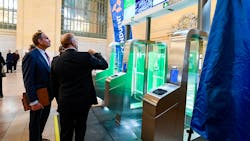MTA loses an estimated $690 million due to fare and toll evasion
The final report from the Metropolitan Transportation Authority’s (MTA) Blue-Ribbon Panel outlines practices to help remedy the authority’s estimated $690 million problem related to fare evasion and unpaid tolls.
The panel included some useful visuals in its report to help illustrate how rampant of a problem fare and toll evasion is for the MTA. In Q4 2022, subway evasion was 13.5 percent, which means about 400,000 riders did not pay on an average weekday. That’s enough to fill Yankee Stadium eight times. On buses, the rate was a staggering 37 percent in Q4 2022, which means an average weekday saw 700,000 bus riders not pay their fares. This would fill Citi Field, where the New York Mets play, 16 times.
“Fare and toll evasion isn’t just an economics problem: It tears at the social contract that supports mass transit in New York City. New Yorkers are sick of feeling like suckers seeing their neighbors beat the fare or cheat the toll while they pony up their fair share,” said MTA Chair and CEO Janno Lieber. “The report findings address this emerging crisis with a comprehensive plan across all MTA services while also acknowledging enforcement alone will not solve this problem. The MTA will look to implement some of the panel’s key recommendations, and we thank them for their tremendous work.”
The “Fareness” Blue-Ribbon Panel was created in 2022 to evaluate innovative ways fare and toll evasion could be addressed through education, equity and enforcement. The 16-member panel, which was co-chaired by Roger Maldonado and Rosemonde Pierre-Louis, issued its final report with recommendations that include modernizing subway fare gates, better supporting low-income transit riders and instituting a generational refresh of enforcement that commits to precision policing and civil enforcement for most evaders. The recommendations will target reducing fare and toll evasion rates and dollar losses by half within three years. The revenues from fares and tolls account for 40 percent of MTA’s operating budget.
“Fare evasion is a crisis that threatens the future of the MTA, and to solve it, the panel believes a rigorous, comprehensive approach to tackle root causes is needed. By bringing New Yorkers together and centering education, equity and changes to the physical entry experience along with a reimagined enforcement strategy, we can alleviate evasion and turn the tide,” Pierre-Louis and Maldonado said.
The panel’s work focused on what it described as the four “Es”: Education, Equity, Environment and Enforcement.
Panel recommendations
The panel called paying fares and tolls a civic duty in the report and explained the time for action is now before the impacts of fare and toll evasion become irreversible. The panel is urging investment in several key areas:
- Modernizing faregates: A long-term capital project the panel says will make it both easier to pay the fare and harder to evade it while increasing accessibility and ease of use for all New Yorkers.
- Better supporting low-income bus and subway riders by expanding and improving the Fair Fares program. The panel wants to see the city of New York double the income standard to make another 500,000 New Yorkers eligible.
- Committing to “precision policing”: New data sources and technology tools can help focus criminal justice resources on the limited number of fare evaders who either pose serious threats to public safety (fare evaders who also commit serious crimes) or who act as evasion enablers (vandalizing MetroCard machines and running fare collection schemes at the exit gates).
- Reducing the well-documented impact of fare evasion enforcement on New Yorkers of color. A new commitment to more equitably distributing enforcement efforts can reduce this. Together, precision policing and more equitable enforcement can build public confidence in and support for the necessary enforcement efforts.
- Shifting to civil enforcement for most evaders – training and deploying more civilian personnel and moving to a new paradigm. For offenders who do not present a public safety concern, enforcement generally should begin with documented, formal warnings on first offense, followed by summonses and fines on subsequent offenses, with enforcement agents using handheld technology to track repeat offenses.
The Blue-Ribbon Panel’s full report can be found on MTA’s website.

Mischa Wanek-Libman | Group Editorial Director
Mischa Wanek-Libman is director of communications with Transdev North America. She has more than 20 years of experience working in the transportation industry covering construction projects, engineering challenges, transit and rail operations and best practices.
Wanek-Libman has held top editorial positions at freight rail and public transportation business-to-business publications including as editor-in-chief and editorial director of Mass Transit from 2018-2024. She has been recognized for editorial excellence through her individual work, as well as for collaborative content.
She is an active member of the American Public Transportation Association's Marketing and Communications Committee and served 14 years as a Board Observer on the National Railroad Construction and Maintenance Association (NRC) Board of Directors.
She is a graduate of Drake University in Des Moines, Iowa, where she earned a Bachelor of Arts degree in Journalism and Mass Communication.


![MTA Chair & CEO Janno Lieber and MTA Bridges & Tunnels President Daniel DeCrescenzo join partner law enforcement agencies at the Bronx-Whitestone Bridge on Friday, May 20, 2022 to announce increased enforcement against obscured and fraudulent license plates. [Marc A. Hermann/MTA] MTA Chair & CEO Janno Lieber and MTA Bridges & Tunnels President Daniel DeCrescenzo join partner law enforcement agencies at the Bronx-Whitestone Bridge on Friday, May 20, 2022 to announce increased enforcement against obscured and fraudulent license plates. [Marc A. Hermann/MTA]](https://img.masstransitmag.com/files/base/cygnus/mass/image/2022/05/16x9/PlateObstruction_marcAHermann_MTA.628ba29f1c760.png?auto=format,compress&fit=crop&q=45&h=139&height=139&w=250&width=250)



